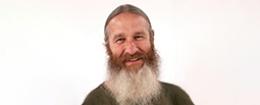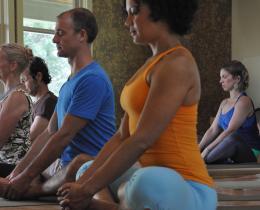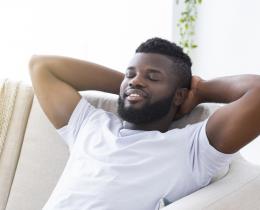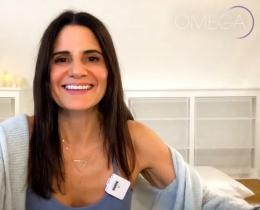What it is: Ashtanga Yoga is a muscle-toning aerobic workout based on flowing variations of Surya Namaskar (Sun Salutation). It is often practiced in a heated room. Sometimes referred to as Power Yoga, Ashtanga Yoga is the inspiration for nearly all vinyasa-style classes that have developed in the West.
What to expect: Students move through a set series of uninterrupted poses that are synchronized with the breath and intended to build strength, flexibility, and stamina. Room temperatures are often set high to promote detoxification through increased perspiration.
Founder: K. Pattabhi Jois (1915-2009)
Year: 1948
Fitness level: high
Practice tips: Because the postures and sequences demand physical exertion in a heated room, overheating and dehydration are possible concerns—so drink plenty of water. Students should consult with their physician before attending.
Keywords: sweaty, hot, physically demanding
Learn more: ashtanga.com
Baptiste Yoga™
What it is: Baptiste Yoga™ is a vigorous, flowing vinyasa style of practice designed to build strength and personal power.
What to expect: The physically demanding vinyasa classes, which include self-inquiry and meditation, are 90 minutes long and are inspired by Baron Baptiste’s studies with B.K.S. Iyengar and T.K.V. Desikachar (both students of T. Krishnamacharya).
Founder: Walt Baptiste (1917-2001) and further developed by his son, Baron Baptiste
Year: 1940s
Fitness level: high
Keywords: powerful, athletic, strength-building
Learn more: baronbaptiste.com
Bikram Yoga®
What it is: Bikram Yoga is a demanding series of 26 asanas and two pranayama practices that are practiced in a hot, humid room.
What to expect: The Bikram Yoga series is designed to flush out toxins (via sweat) while progressively warming up and stretching your muscles, ligaments, and tendons. Teachers crank the thermostat up to 105 degrees and create an environment of about 40% humidity. They lead their students through the same series in every class, holding each pose for at least 10 seconds. In some advanced classes, the series is completed twice.
Founder: Bikram Choudhury (who studied with Paramahansa Yogananda’s brother, Bishnu Ghosh)
Year: 1970s
Fitness level: high
Practice tips: Consult with physician before taking a class to make sure you’re healthy enough to participate. And stay hydrated (before, during, and after class).
Keywords: hot, sweaty, physically demanding
Learn more: bikramyoga.com
Children’s Yoga
What it is: Thanks to yoga’s popularity and ongoing research about the benefits of the practice, there are a wide variety of yoga classes for children (and teacher training programs for those who’d like to share the practice with them). The classes are designed to improvechildren's flexibility, focus, and body awareness.
What to expect: Children’s yoga classes are generally play-based. They often integrate stories about poses, games, and age-appropriate approaches to working with the breath. Sometimes, children learn a sequence via a story (which is often animal-themed) or they’re encouraged to create a story to match poses. Teachers often integrate art projects, music, and discussion into their classes to keep kids engaged.
Founder: n/a
Year: unknown
Fitness level: all levels
Keywords: fun, playful, creative
Forrest Yoga
What it is: Forrest Yoga is a highly physical, emotionally intense form of practice that is performed in a heated room. Students build strength and flexibility while explicitly addressing mental and emotional issues—all in an effort to find healing and wholeness.
What to expect: Expect to learn strong sequences of poses (with long holds), do serious emotional work, and strengthen your core in this practice, which is intensified by the heat.
Founder: Ana Forrest
Year: 1982
Fitness level: high
Practice tips: Consult with physician before taking a class to make sure you’re healthy enough to participate. Drink plenty of water to avoid dehydration.
Keywords: strong, intense, emotional
Learn more: forrestyoga.com
Hatha Yoga
What it is: Hatha yoga is the traditional practice of asanas (physical postures) and pranayama (breathing practices). Developed in medieval times, it has the same objective as other forms of yoga: self-transformation. And it’s where all of today’s forms of asana practice stem from.
What to expect: Yoga classes that are called hatha yoga tend to be gentle, slower-paced classes that focus on basic postures, simple breathing techniques, relaxation practice, and (perhaps) meditation. More advanced classes encourage longer holds and introduce practices like the bandhas (locks) and the kriyas (cleansing practices).
Founder: Goraksha Natha
Year: 10th or 11th century
Fitness level: all levels
Keywords: gentle, methodical, traditional
Hot Yoga
What it is: Hot yoga refers to classes that offer yoga practices in artificially heated conditions, such as Bikram Yoga, Forrest Yoga, and power yoga.
What to expect: Hot yoga classes demand a high level of endurance. The heat is said to promote detoxification and increase flexibility, so you can go deeper in poses than you normally would without injuring yourself.
Founder: n/a
Year: unknown
Fitness level: high
Practice tips: Consult with physician before taking a class to make sure you’re healthy enough to participate. Drink plenty of water to avoid dehydration.
Keywords: sweaty, hot, challenging
Integral Yoga®
What it is: Integral Yoga is a gentle hatha yoga practice with a spiritual focus.
What to expect: Classes begin with 45 minutes of breath-centric yoga postures, followed by deep relaxation, a breathing sequence, and a meditation. They can include kriyas (cleansing practices) and chanting. The goal of the practice is self-transformation on four levels—physical, mental, emotional, and spiritual—leading to an experience of spiritual unity.
Founder: Swami Satchidananda (1914-2002), an Indian spiritual teacher and yoga adept who gained fame in the West during his time in New York from 1966 to 1972
Year: 1966
Fitness level: all levels; teachers offer modifications to make the practice accessible to people of all ages, sizes, and abilities
Keywords: gentle, traditional, spiritual
Learn more: yogaville.org
Integrative Yoga Therapy (IYT)
What it is: Integrative Yoga Therapy takes a body-mind-spirit approach to healing, offering a smorgasbord of tailored (but traditional) yogic practices. Individuals can choose one-on-one sessions and classes geared toward specific peer groups, such as seniors, moms-to-be, or patients with cancer or heart disease.
What to expect: In any given class, you might learn specific asanas, pranayamas, mantras, yoga nidra practices, mudras (sealing gestures), and meditations tailored specifically for your needs.
Founder: Joseph Le Page (a yoga teacher in the Kripalu tradition and an energy healing body-worker)
Year: 1993
Fitness level: all levels
Keywords: healing, experiential, transformational
Learn more: iytyogatherapy.com
Iyengar Yoga







